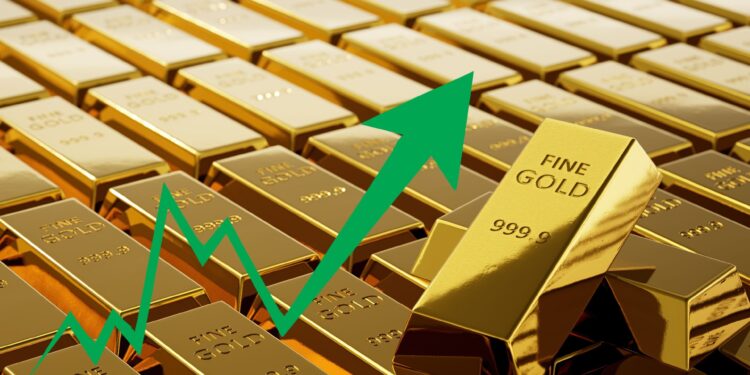Spot gold contracts recorded the highest historical level in yesterday’s trading, Monday, exceeding the previous level recorded in August 2020, and analysts believe that the Israeli aggression against the Gaza Strip has escalated. The resulting tensions in the region and the world played an important role in supporting the yellow metal, in addition to other factors.
In Monday’s session, spot contract prices reached $2,110 per ounce, while futures contract prices reached $2,130, compared to the previous historical level of $2,072, recorded in August 2020.
The rise in the price of gold globally is due to several main factors, the most prominent of which is the continuation of the aggression launched by Israel against the Gaza Strip two months ago and the tensions it has caused, not at the regional level, but rather at the world level, as the Middle East region is considered of great economic importance, due to its richness in oil and natural gas. In addition to its supervision of important waterways, most notably the Suez Canal, Bab al-Mandab, and the Strait of Hormuz.
As for the entry of the Houthi group in Yemen into the crisis line and threatening Israeli ships or those who deal with Israel, it has fueled global fears and threatened navigation through Bab al-Mandab, in addition to fears of the war expanding to a regional level, and then gold prices jumped.
Last Sunday, the Yemeni Houthi group announced that it had targeted two Israeli ships in the Bab al-Mandab Strait, with a naval missile and a drone.
Then, the British Maritime Agency warned of a “possible explosion” in the Bab al-Mandab Strait, from the direction of Yemen, and called on ships to “exercise caution.”
Last November 19, the Houthis announced the seizure of the “Galaxy Leader” cargo ship owned by an Israeli businessman in the Red Sea, and taking it to the Yemeni coast, in solidarity with the Palestinian resistance.
Tension still exists between Israel and the resistance in southern Lebanon, led by Hezbollah. Hardly a day goes by without mutual attacks occurring on both sides of the border.
Unrest usually creates new investors who try to turn to gold as a safe haven, but they believe that the yellow metal will not be a permanent safe haven and they expect the price to rise significantly if the worst scenario occurs, which is Iran entering a direct party in the conflict.
Other causes
In addition to the global economy’s fears of the effects associated with Middle East tensions, there are other data that pushed the yellow metal upward, including the decline of the dollar, and the return of central banks to an accelerating demand for gold.
During the past 11 months, the average price of an ounce of gold reached $1,890, compared to an average of $1,830 in 2022.
Central banks increased demand for gold during the last quarter of this year, compared to the first three quarters of the year, which gave a good boost to gold prices.
In addition, one of the big drivers of gold is the demand from wealthy consumers in emerging markets, especially from India, according to a report reported by Bloomberg.
The agency’s report also indicates a tendency to reduce dependence on the dollar by many countries, in addition to the possibility of China purchasing gold as a means of diversifying away from US government bonds, which has led to support for gold prices.
Despite the decline in global inflation rates, after sharp increases in global interest rates, many consumers still feel expensive, as they suffer from high prices and high interest rates. This has led to increased interest in gold investments, as it is considered a smart hedge against inflation and a good way to protect wealth in turbulent economic times.
Ascension procession
Gold prices are much higher than they were just a few years ago, rising from about $1,200 per ounce in October 2018 to more than $2,100 per ounce yesterday, Monday.
The decline of the dollar index by 3.4% last November stimulated demand for gold, and investors moved from funds denominated in the US currency to funds denominated in the yellow metal.
The decline in the dollar index is due to market expectations and the end of the monetary tightening journey by central banks led by the US Federal Reserve (the central bank), which raised interest rates 11 times since March 2022, to settle at the level of 5.5%.
Other reasons supporting gold prices include the continuation of the war in Ukraine, as well as the continuation of tension between China and the United States.



